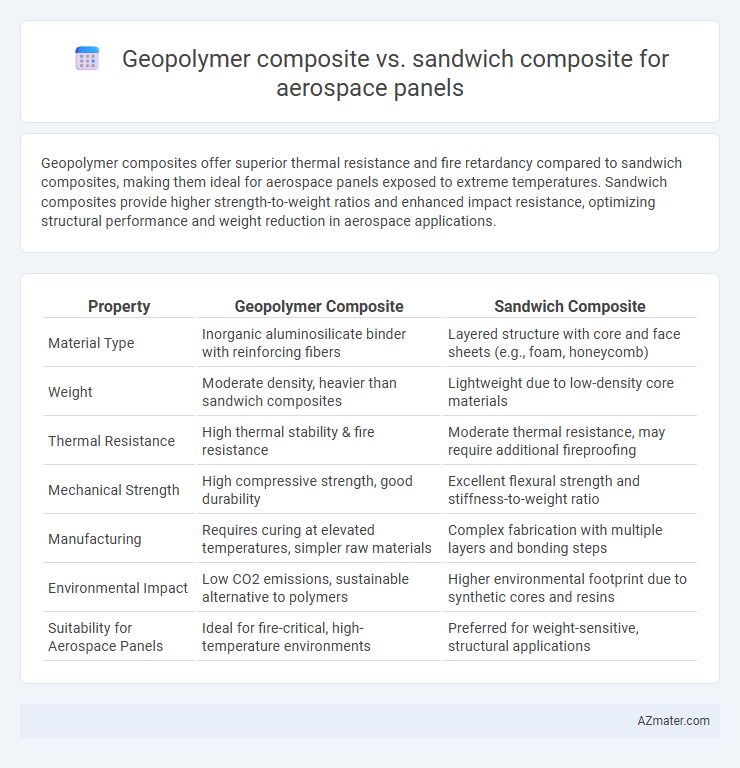Geopolymer composites offer superior thermal resistance and fire retardancy compared to sandwich composites, making them ideal for aerospace panels exposed to extreme temperatures. Sandwich composites provide higher strength-to-weight ratios and enhanced impact resistance, optimizing structural performance and weight reduction in aerospace applications.
Table of Comparison
| Property | Geopolymer Composite | Sandwich Composite |
|---|---|---|
| Material Type | Inorganic aluminosilicate binder with reinforcing fibers | Layered structure with core and face sheets (e.g., foam, honeycomb) |
| Weight | Moderate density, heavier than sandwich composites | Lightweight due to low-density core materials |
| Thermal Resistance | High thermal stability & fire resistance | Moderate thermal resistance, may require additional fireproofing |
| Mechanical Strength | High compressive strength, good durability | Excellent flexural strength and stiffness-to-weight ratio |
| Manufacturing | Requires curing at elevated temperatures, simpler raw materials | Complex fabrication with multiple layers and bonding steps |
| Environmental Impact | Low CO2 emissions, sustainable alternative to polymers | Higher environmental footprint due to synthetic cores and resins |
| Suitability for Aerospace Panels | Ideal for fire-critical, high-temperature environments | Preferred for weight-sensitive, structural applications |
Introduction to Aerospace Panel Materials
Aerospace panels demand materials with superior strength-to-weight ratios, thermal stability, and corrosion resistance. Geopolymer composites offer high thermal resistance and fire-retardant properties due to their inorganic polymer matrix, making them suitable for high-temperature aerospace applications. Sandwich composites combine lightweight core materials like foam or honeycomb with strong face sheets, optimizing stiffness and impact resistance while minimizing weight for aerodynamic efficiency.
Overview of Geopolymer Composite Panels
Geopolymer composite panels, made from inorganic aluminosilicate polymers, offer exceptional thermal resistance, low density, and high mechanical strength ideal for aerospace applications. These panels provide superior fire resistance and dimensional stability compared to traditional sandwich composites, which typically consist of fiber-reinforced polymer facesheets bonded to a lightweight core. The inorganic matrix of geopolymer composites enhances durability under extreme temperature and chemical exposure, making them a promising alternative for aerospace structural panels requiring high performance and sustainability.
Fundamentals of Sandwich Composite Construction
Sandwich composites in aerospace panels consist of two strong outer skins bonded to a lightweight core, optimizing stiffness-to-weight ratio and enhancing impact resistance. Geopolymer composites, while offering excellent thermal stability and fire resistance, typically lack the tailored anisotropic strength and flexibility found in traditional sandwich composite cores like honeycomb or foam. Understanding the interplay between face sheets and core materials is fundamental to sandwich composite construction, enabling high-performance aerospace panels with superior mechanical properties compared to geopolymer alternatives.
Mechanical Properties Comparison
Geopolymer composites exhibit higher thermal stability and enhanced compressive strength compared to sandwich composites, making them suitable for high-temperature aerospace panel applications. Sandwich composites typically provide superior flexural rigidity and lower density, contributing to weight reduction in aerospace structures. Mechanical properties such as tensile strength and impact resistance are generally higher in sandwich composites due to their multi-layered construction, while geopolymer composites offer improved fire resistance and durability under extreme environments.
Weight and Density Analysis
Geopolymer composites exhibit higher density compared to sandwich composites, resulting in increased weight, which challenges aerospace applications prioritizing lightweight structures. Sandwich composites, featuring lightweight core materials such as honeycomb or foam, offer superior strength-to-weight ratios and lower density, significantly reducing panel weight in aerospace designs. Weight and density analysis confirms sandwich composites are more advantageous for aerospace panels requiring minimal mass without compromising structural integrity.
Thermal and Fire Resistance Performance
Geopolymer composites exhibit superior thermal stability and fire resistance compared to traditional sandwich composites used in aerospace panels, maintaining structural integrity at temperatures exceeding 1000degC due to their inorganic polymer matrix. Sandwich composites, typically composed of polymeric resin and lightweight core materials, offer lower thermal resistance and can degrade or emit toxic fumes under high heat exposure. The enhanced fire-resistant properties of geopolymer composites make them ideal for aerospace applications requiring stringent safety and thermal management standards.
Durability and Environmental Resistance
Geopolymer composites demonstrate superior thermal stability and fire resistance compared to traditional sandwich composites, making them highly durable in extreme aerospace environments. Their inorganic matrix offers enhanced resistance to moisture, UV radiation, and chemical degradation, which prolongs service life under harsh atmospheric conditions. Sandwich composites, while lightweight and mechanically efficient, are more susceptible to delamination and environmental aging that can compromise structural integrity over time.
Manufacturing Process and Cost Efficiency
Geopolymer composites offer a manufacturing process that involves lower curing temperatures and reduced energy consumption compared to sandwich composites, which typically require complex layering and adhesive bonding steps. The simplified production of geopolymer panels minimizes tooling costs and shortens cycle times, enhancing overall cost efficiency. In contrast, sandwich composites, while providing superior strength-to-weight ratios, incur higher expenses due to raw material costs and intricate fabrication techniques.
Sustainability and Environmental Impact
Geopolymer composites exhibit superior sustainability compared to sandwich composites in aerospace panels due to their use of industrial by-products like fly ash and slag, significantly reducing carbon emissions during production. The lower energy consumption in curing geopolymer matrices and their inherent fire resistance enhance environmental performance without compromising mechanical strength. Conversely, sandwich composites often rely on synthetic foams and resins with higher environmental footprints and limited recyclability, increasing end-of-life disposal challenges.
Application Suitability in Aerospace Panel Design
Geopolymer composites offer exceptional thermal stability and fire resistance, making them ideal for aerospace panels exposed to high temperatures and harsh environments. Sandwich composites provide superior strength-to-weight ratios and impact resistance, crucial for structural components requiring lightweight durability and energy absorption. Selecting between geopolymer and sandwich composites depends on prioritizing thermal properties versus mechanical performance in aerospace panel design.

Infographic: Geopolymer composite vs Sandwich composite for Aerospace panel
 azmater.com
azmater.com